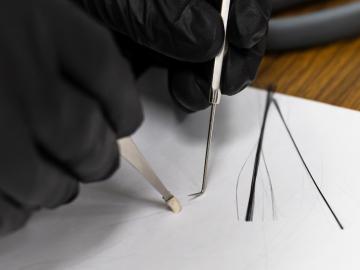
Filter News
Area of Research
- Biological Systems (1)
- Biology and Environment (44)
- Biology and Soft Matter (1)
- Computational Biology (1)
- Energy Science (38)
- Fusion and Fission (19)
- Fusion Energy (4)
- Isotopes (18)
- Materials (34)
- Materials for Computing (3)
- National Security (14)
- Neutron Science (14)
- Nuclear Science and Technology (16)
- Quantum information Science (2)
- Supercomputing (37)
News Type
News Topics
- (-) Biomedical (42)
- (-) Cybersecurity (14)
- (-) Energy Storage (32)
- (-) Exascale Computing (51)
- (-) Isotopes (33)
- (-) Mercury (7)
- (-) Microscopy (23)
- (-) Nuclear Energy (66)
- (-) Physics (34)
- (-) Space Exploration (13)
- 3-D Printing/Advanced Manufacturing (56)
- Advanced Reactors (12)
- Artificial Intelligence (77)
- Big Data (45)
- Bioenergy (68)
- Biology (80)
- Biotechnology (25)
- Buildings (30)
- Chemical Sciences (35)
- Clean Water (16)
- Composites (11)
- Computer Science (111)
- Coronavirus (19)
- Critical Materials (5)
- Education (2)
- Emergency (3)
- Environment (116)
- Fossil Energy (6)
- Frontier (44)
- Fusion (38)
- Grid (32)
- High-Performance Computing (81)
- Hydropower (6)
- ITER (4)
- Machine Learning (37)
- Materials (51)
- Materials Science (55)
- Mathematics (8)
- Microelectronics (3)
- Molten Salt (2)
- Nanotechnology (17)
- National Security (60)
- Neutron Science (82)
- Partnerships (36)
- Polymers (9)
- Quantum Computing (35)
- Quantum Science (48)
- Security (16)
- Simulation (42)
- Software (1)
- Statistics (2)
- Summit (40)
- Transportation (30)
Media Contacts

Stronger than steel and lighter than aluminum, carbon fiber is a staple in aerospace and high-performance vehicles — and now, scientists at ORNL have found a way to make it even stronger.

Jesse Labbé aims to leverage biology, computation and engineering to address societal challenges related to energy, national security and health, while enhancing U.S. competitiveness. Labbé emphasizes the importance of translating groundbreaking research into practical applications that have real-world impact.
Robert “Bob” Hettich, an ORNL Corporate Fellow, is a pioneer in using mass spectrometry to uncover how microbes interact within complex environments and influence larger systems like plants and humans. A founder of the field of metaproteomics, he leads research that supports bioenergy, environmental resilience and health through advanced protein analysis.

ORNL researchers helped introduce college students to quantum computing for the first time during the 2025 Winter Classic Invitational, providing hands-on access to real quantum hardware and training future high-performance computing users through a unique challenge that bridged classical and quantum technologies.

Scientists at the Department of Energy’s Oak Ridge National Laboratory recently welcomed Vanderbilt University colleagues for a symposium on basic science research, with a focus on potential collaborations in the biomedical and biotechnology spaces.

The Innovative and Novel Computational Impact on Theory and Experiment, or INCITE, program has announced the 2026 Call for Proposals, inviting researchers to apply for access to some of the world’s most powerful high-performance computing systems.
Daniel Jacobson, distinguished research scientist in the Biosciences Division at ORNL, has been elected a Fellow of the American Institute for Medical and Biological Engineering, or AIMBE, for his achievements in computational biology.

A team from ORNL, joined by university students, recently traveled to the Ohio State University Research Reactor to conduct a novel experiment on nuclear thermal rocket fuel coatings — one that could help propel NASA’s astronauts to Mars faster and more efficiently.

Researchers from ORNL have developed a new application to increase efficiency in memory systems for high performance computing. Rather than allow data to bog down traditional memory systems in supercomputers and impact performance, the team from ORNL, along with researchers from the University of Tennessee, Knoxville, created a framework to manage data more efficiently with memory systems that employ more complex structures.

Jairus Hines, an electronics and unmanned systems technician at ORNL, works with airborne, waterborne and ground-based drones. As part of the lab’s Autonomous Systems group, he applies "low and slow" drone technology to radiation detection for national security missions.


